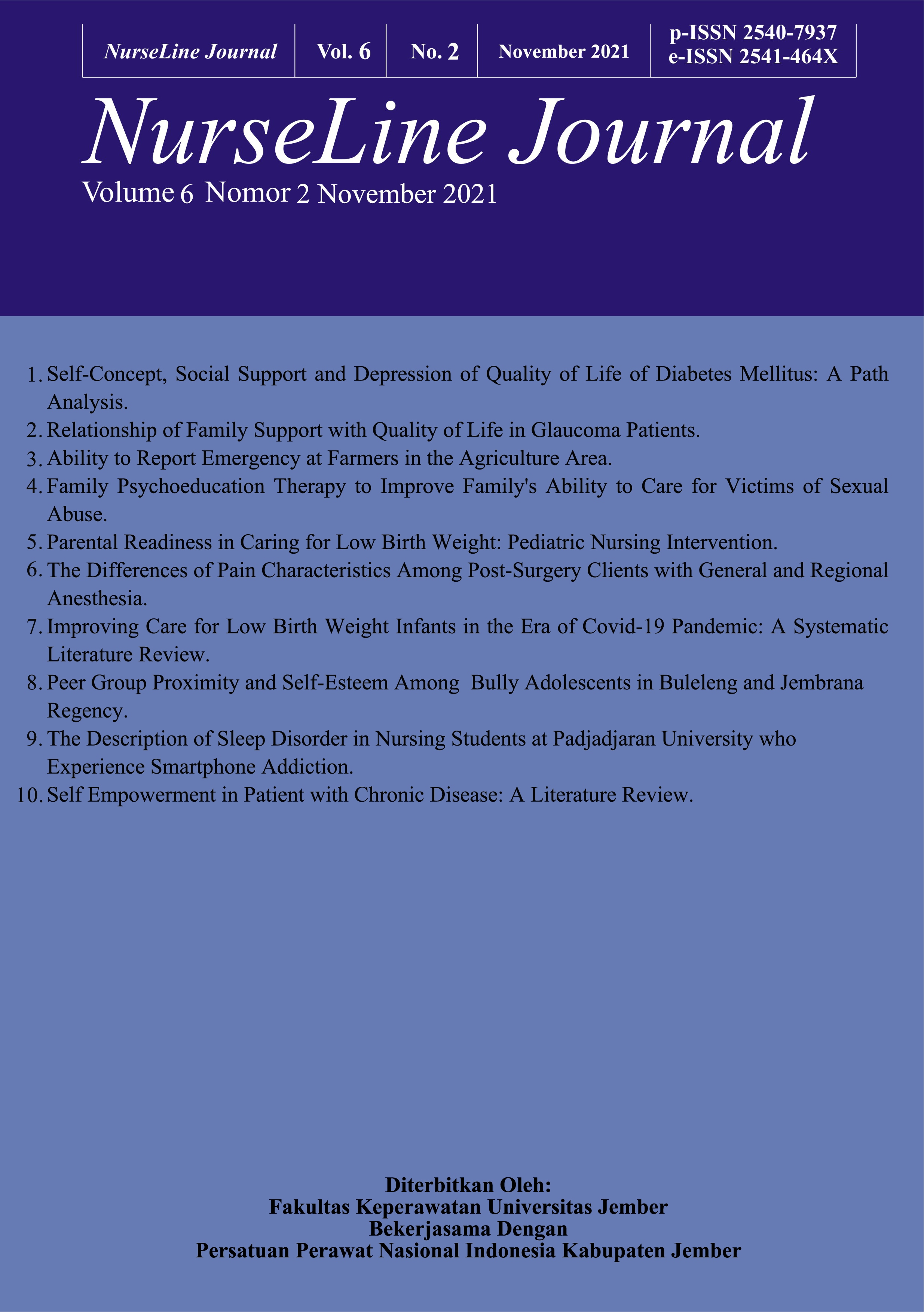The Description of Sleep Disorder In Nursing Students At Padjadjaran University Who Experience Smartphone Addiction
DOI:
https://doi.org/10.19184/nlj.v6i2.19725Keywords:
smartphone addiction, nursing student, sleep disorderAbstract
Background: Sleep disorders can be experienced by college students, including nursing students. Nursing students are prospective professional nurses, if they experience sleep disorders it is feared that it will have a negative impact during lectures and health services that will be provided when becoming a nurse later. Purpose: This study aims to determine the description of sleep disorders in nursing students at Padjadjaran University who experience smartphone addiction. Methods: The method used in this research was quantitative descriptive method. The population in this research was the nursing students of Padjadjaran University, with a total of 668 respondents using purposive sampling technique, obtained a total sample of 400 respondents. The instrument used in this study was the Sleep Disorders Symptom Checklist-17 (SDS-CL-17). The data obtained were analyzed using univariate analysis with results presented in percentage. Results: The result of this study showed that the majority of respondents (99.8%) experienced sleep disorders. Based on the sleep disorders category, the majority of respondents experienced circadian rhythmic sleep-wake disorder (91.8%) and parasomnia (76%), while less than half of the respondents also experienced insomnia (46.2%), narcolepsy (45.8 %), sleep-related movement disorders (36.2%) and obstructive sleep apnea (30.8%) and experienced two or more sleep disorders (89%). Conclusion: The high incidence of sleep disorders indicated the need for preventive, promotive, curative and rehabilitative solutions for nursing students to reduce the impact that can be caused in the future.
Downloads
References
Arikunto, S., 2013. Prosedur Penelitian: Suatu Pendekatan Praktik, Jakarta: Rineka Cipta.
Arthy, C.C. et al., 2019. Indonesian Version of Addiction Rating Scale of Smartphone Usage Adapted from Smartphone Addiction Scale-Short Version ( SAS-SV ) In Junior High School. Journal of Medical Sciences, 7(19), pp.3235–3239.
California Department of Public Health [CDPH], 2017. How to Reduce Exposure to Radiofrequency Energy from Cell Phones. Available at: https://www.cdph.ca.gov/Programs/CCDPHP/DEODC/EHIB/CDPH Document Library/Cell-Phone-Guidance.pdf.
Chen, B. et al., 2017. Gender differences in factors associated with smartphone addiction : a cross- sectional study among medical college students. , pp.1–9.
Demirci, K., Akgonul, M. & Akpinar, A., 2015. Relationship of smartphone use severity with sleep quality , depression , and anxiety in university students. Journal of Behavioral Addictions, 4(2), pp.85–92.
Dewi, R.K. et al., 2018. Adolescents’ smartphone use at night, sleep disturbance and depressive symptoms. International Journal of Adolescent Medicine and Health, pp.1–8.
Ghozali, I., 2011. Aplikasi Analisis Multivariate Dengan Program IBM SPSS19 IV., Semarang: Badan Penerbit Universitas Diponegoro.
Gobin, C.M. et al., 2015. Poor sleep and cognitive bias Poor sleep quality is associated with a negative cognitive bias and decreased sustained attention. , pp.535–542.
Grandner, M.A., 2019. Sleep and Health, London: Elsevier.
Gunanthi, N.M.W.M. & Diniari, N.K.S., 2016. Prevalensi Dan Gambaran Gangguan Tidur Berdasarkan Karakteristik Mahasiswa Semester I Program Studi Pendidikan Dokter Fakultas Kedokteran Universitas Udayana Tahun 2015. E-JOURNAL MEDIKA, 5(4), pp.1–9.
Hall, J.E., 2014. Guyton & Hall Textbook of Medical Physiology - E-Book A South As. K. D. A. Mario Dr. Vaz, Tony Dr. Raj, ed., Elsevier Health Sciences.
Hallit, S. et al., 2019. Impact of sleep disorders and other factors on the quality of life in general population. The Journal of Nervous and Mental Disease, 207(5), pp.333–339.
Hartinah, S., Sriati, A. & Kosasih, C.E., 2019. Gambaran tingkat gejala kecanduan media sosial pada mahasiswa keperawatan Universitas Padjadjaran. Jurnal Keperawatan BSI, VII(1), pp.123–133.
Hershner, S.D. & Chervin, R.D., 2014. Causes and consequences of sleepiness among college students. Nature and Science of Sleep, pp.73–84.
Hidayat, S. & Mustikasari, 2014. Kecanduan penggunaan smartphone dan kualitas tidur pada mahasiswa RIK UI. , pp.1–10.
Kasiati & Rosmalawati, N.W.D., 2016. Kebutuhan Dasar Manusia 1, Jakarta Selatan: Kementrian Kesehatan Republik Indonesia (Pusdik SDM Kesehatan : Badan Pengembangan dan Pemberdayaan Sumber Daya Manusia Kesehatan.
Kaur, S., Kaur, J. & Sandhu, M., 2016. Effects of mobile radiations and its prevention. International Journal of Computer Science and Mobile Computing, 5(2), pp.298–304.
Kementrian Kesehatan Republik Indonesia, 2019. Bijak gunakan smartphone agar tidak ketergantungan. , pp.2–3. Retrived from : www.depkes.go.id/pdf.php?id=18070600008 on 10:58 WIB, 24 October 2019.
Kim, H. et al., 2017. Accident risk associated with smartphone addiction : A study on university students in Korea. , 6(4), pp.699–707.
Klingman, K.J., Jungquist, C.R. & Perlis, M.L., 2017. Introducing the Sleep Disorders Symptom Checklist-25 : A primary care friendly and comprehensive screener for sleep disorders. Sleep Medicine Reviews, pp.1087–792.
Klingman, K.J., Jungquist, C.R. & Perlis, M.L., 2016. Questionnaires that screen for multiple sleep disorders. , pp.1–8.
Krueger, J.M. et al., 2016. Sleep function : Toward elucidating an enigma. Sleep Medicine Reviews, 28, pp.46–54. Available at: http://dx.doi.org/10.1016/j.smrv.2015.08.005.
Kurugodiyavar, M.D. et al., 2018. Impact of smartphone use on quality of sleep among medical students. International Journal of Community Medicine and Public Health, 5(1), pp.101–109.
Kwon, M. et al., 2013. The Smartphone Addiction Scale : Development and Validation of a Short Version for Adolescents. , 8(12), pp.1–7.
Lee, H., Ahn, H. & Choi, S., 2014. The SAMS : Smartphone Addiction Management System and verification. J Med Syst, 38:1.
Lin, Y. et al., 2016. Proposed Diagnostic Criteria for Smartphone Addiction. , (2), pp.1–11.
Mayo Foundation for Medical Education and Research [MFMER], 2019. Sleep Disorders. Available at: https://www.mayoclinic.org/diseases-conditions/sleep-disorders/symptoms-causes/syc-20354018 [Accessed January 19, 2020].
National Institusie of Neurological Disorders and Stroke [NINDS], 2019. Brain Basics: Understanding Sleep. Available at: https://www.ninds.nih.gov/disorders/Patient-Caregiver-Education/Understanding-Sleep [Accessed January 18, 2020].
National Sleep Foundation [NSF], 2020. How Medications May Affect Sleep. Available at: https://www.sleepfoundation.org/articles/how-medications-may-affect-sleep [Accessed January 24, 2020].
National Sleep Foundation [NSF], 2019. What Good Quality Sleep. Available at: https://www.sleepfoundation.org/press-release/what-good-quality-sleep [Accessed January 17, 2020].
National Sleep Foundation [NSF], 2011. 2011 Sleep in America Poll : Communications Technology in the Bedroom, Washington DC: WBA.
Notoatmodjo, S., 2012. Metodologi Penelitian Kesehatan, Jakarta: Rineka Cipta.
Nowreen, N. & Ahad, F., 2018. Effect of smartphone usage on quality of sleep in medical students. , 8(10), pp.4–9.
Nurfadilah, S., Ahmad, R.A. & Julia, M., 2017. Aktivitas fisik dan screen based activity dengan pola tidur remaja di Wates. (BKM Journal of Community Medicine and Public Health), 33 No. 7, pp.343–350.
Ohayon, M. et al., 2017. National Sleep Foundation ’ s sleep quality recommendations : first report ☆. Sleep Health: Journal of the National Sleep Foundation, 3(1), pp.6–19. Available at: http://dx.doi.org/10.1016/j.sleh.2016.11.006.
Parekh, R., 2017. What Are Sleep Disorders? Available at: https://www.psychiatry.org/patients-families/sleep-disorders/what-are-sleep-disorders [Accessed January 17, 2020].
Petrov, M.E., Lichstein, K.L. & Baldwin, C.M., 2014. Prevalence of sleep disorders by sex and ethnicity among older adolescents and emerging adults : Relations to daytime functioning , working memory and mental health. Journal of Adolescence, 37(5), pp.587–597. Available at: http://dx.doi.org/10.1016/j.adolescence.2014.04.007.
Rawlins, B., 2015. Mobile Devices : A Practical Guide for Librarians, London: Rowman & Littlefield.
Redeker, N.S. & McEnany, G.P., 2011. Sleep Disorders and Sleep Promotion in Nursing Practice, New York: Springer Publishing Company.
Rodrigues, T., Diego, D.L. & Santos, A., 2018. Association of sleep quality with sociodemographic factors and lifestyle in adolescents from southern Brazil. World Journal of Pediatrics, (123456789). Available at: https://doi.org/10.1007/s12519-018-0136-8.
Sarfriyanda, J., Karim, D. & Dewi, A.P., 2015. Hubungan antara kualitas tidur dan kuantitas tidur dengan prestasi belajar mahasiswa. JOM, 2(2).
Sateia, M.J., 2014. International Classification Of Sleep Disorder-Third Edition : Highlight and modifications. CHEST, 146(5), pp.1387–1394. Available at: http://dx.doi.org/10.1378/chest.14-0970.
Sugiyono, 2017. Metode Penelitian Kuantitatif, Kualitatif, dan R&D, Bandung: Alvabeta CV.
Valerio, T.D., Kim, M.J. & Sexton-radek, K., 2016. Association of Stress , General Health , and Alcohol Use with Poor Sleep Quality among U . S . College Students. , 5037(February).
Wang, P. et al., 2019. Relationship of sleep quality , smartphone dependence , and health-related behaviors in female junior college students. , pp.1–12.
Waqas, A. et al., 2015. Association of academic stress with sleeping di ffi culties in medical students of a Pakistani medical school: a cross sectional survey.
Wu, X. et al., 2015. Low Physical Activity and High Screen Time Can Increase the Risks of Mental Health Problems and Poor Sleep Quality among Chinese College Students. , pp.1–10.
Yolanda, A.A. et al., 2019. Hubungan aktivitas fisik, screen based activity dan sleep hygien dengan kualitas tidur pada remaja usia 15-18 tahun. JURNAL KESEHATAN MASYARAKAT (e-Journal), 7 No. 1, pp.123–130.








